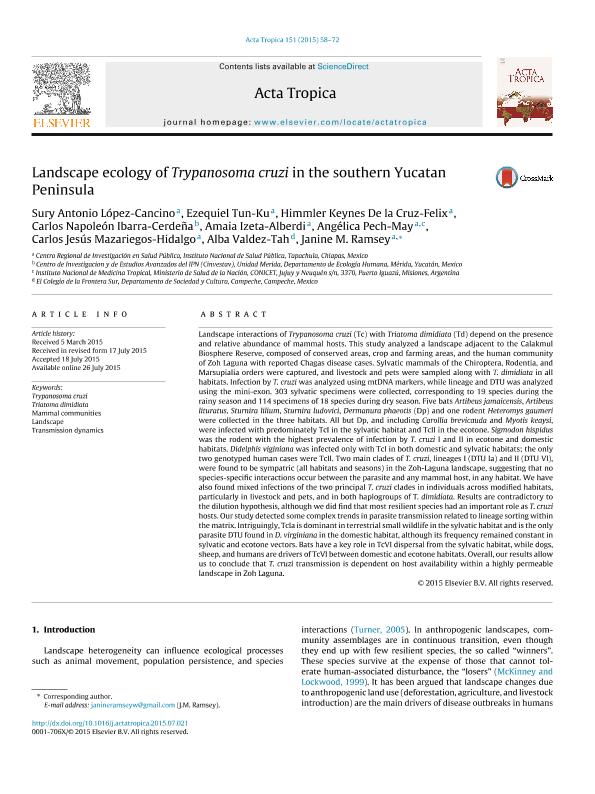Mostrar el registro sencillo del ítem
dc.contributor.author
López Cancino, Sury Antonio
dc.contributor.author
Tun Ku, Ezequiel
dc.contributor.author
De la Cruz Felix, Himmler Keynes
dc.contributor.author
Ibarra Cerdena, Carlos Napoleón
dc.contributor.author
Izeta Alberdi, Amaia
dc.contributor.author
Pech May, Angélica del Rosario

dc.contributor.author
Mazariegos Hidalgo, Carlos Jesús
dc.contributor.author
Valdez Tah, Alba Rocio

dc.contributor.author
Ramsey, Janine

dc.date.available
2019-05-15T20:41:05Z
dc.date.issued
2015-03
dc.identifier.citation
López Cancino, Sury Antonio; Tun Ku, Ezequiel; De la Cruz Felix, Himmler Keynes; Ibarra Cerdena, Carlos Napoleón; Izeta Alberdi, Amaia; et al.; Landscape ecology of Trypanosoma cruzi in the southern Yucatan Peninsula; Elsevier Science; Acta Tropica; 151; 1; 3-2015; 58-72
dc.identifier.issn
0001-706X
dc.identifier.uri
http://hdl.handle.net/11336/76488
dc.description.abstract
Landscape interactions of Trypanosoma cruzi (Tc) with Triatoma dimidiata (Td) depend on the presence and relative abundance of mammal hosts. This study analyzed a landscape adjacent to the Calakmul Biosphere Reserve, composed of conserved areas, crop and farming areas, and the human community of Zoh Laguna with reported Chagas disease cases. Sylvatic mammals of the Chiroptera, Rodentia, and Marsupialia orders were captured, and livestock and pets were sampled along with T. dimidiata in all habitats. Infection by T. cruzi was analyzed using mtDNA markers, while lineage and DTU was analyzed using the mini-exon. 303 sylvatic specimens were collected, corresponding to 19 species during the rainy season and 114 specimens of 18 species during dry season. Five bats Artibeus jamaicensis, Artibeus lituratus, Sturnira lilium, Sturnira ludovici, Dermanura phaeotis (Dp) and one rodent Heteromys gaumeri were collected in the three habitats. All but Dp, and including Carollia brevicauda and Myotis keaysi, were infected with predominately TcI in the sylvatic habitat and TcII in the ecotone. Sigmodon hispidus was the rodent with the highest prevalence of infection by T. cruzi I and II in ecotone and domestic habitats. Didelphis viginiana was infected only with TcI in both domestic and sylvatic habitats; the only two genotyped human cases were TcII. Two main clades of T. cruzi, lineages I (DTU Ia) and II (DTU VI), were found to be sympatric (all habitats and seasons) in the Zoh-Laguna landscape, suggesting that no species-specific interactions occur between the parasite and any mammal host, in any habitat. We have also found mixed infections of the two principal T. cruzi clades in individuals across modified habitats, particularly in livestock and pets, and in both haplogroups of T. dimidiata. Results are contradictory to the dilution hypothesis, although we did find that most resilient species had an important role as T. cruzi hosts. Our study detected some complex trends in parasite transmission related to lineage sorting within the matrix. Intriguingly, TcIa is dominant in terrestrial small wildlife in the sylvatic habitat and is the only parasite DTU found in D. virginiana in the domestic habitat, although its frequency remained constant in sylvatic and ecotone vectors. Bats have a key role in TcVI dispersal from the sylvatic habitat, while dogs, sheep, and humans are drivers of TcVI between domestic and ecotone habitats. Overall, our results allow us to conclude that T. cruzi transmission is dependent on host availability within a highly permeable landscape in Zoh Laguna.
dc.format
application/pdf
dc.language.iso
eng
dc.publisher
Elsevier Science

dc.rights
info:eu-repo/semantics/openAccess
dc.rights.uri
https://creativecommons.org/licenses/by-nc-sa/2.5/ar/
dc.subject
LANDSCAPE
dc.subject
MAMMAL COMMUNITIES
dc.subject
TRANSMISSION DYNAMICS
dc.subject
TRIATOMA DIMIDIATA
dc.subject
TRYPANOSOMA CRUZI
dc.subject.classification
Otras Ciencias Biológicas

dc.subject.classification
Ciencias Biológicas

dc.subject.classification
CIENCIAS NATURALES Y EXACTAS

dc.title
Landscape ecology of Trypanosoma cruzi in the southern Yucatan Peninsula
dc.type
info:eu-repo/semantics/article
dc.type
info:ar-repo/semantics/artículo
dc.type
info:eu-repo/semantics/publishedVersion
dc.date.updated
2019-05-10T14:10:09Z
dc.journal.volume
151
dc.journal.number
1
dc.journal.pagination
58-72
dc.journal.pais
Países Bajos

dc.journal.ciudad
Amsterdam
dc.description.fil
Fil: López Cancino, Sury Antonio. Instituto Nacional de Salud Pública; México
dc.description.fil
Fil: Tun Ku, Ezequiel. Instituto Nacional de Salud Pública; México
dc.description.fil
Fil: De la Cruz Felix, Himmler Keynes. Instituto Nacional de Salud Pública; México
dc.description.fil
Fil: Ibarra Cerdena, Carlos Napoleón. Instituto Politécnico Nacional. Centro de Investigación y de Estudios Avanzados; México;
dc.description.fil
Fil: Izeta Alberdi, Amaia. Instituto Nacional de Salud Publica; México
dc.description.fil
Fil: Pech May, Angélica del Rosario. Consejo Nacional de Investigaciones Científicas y Técnicas; Argentina. Ministerio de Salud. Instituto Nacional de Medicina Tropical; Argentina. Instituto Nacional de Salud Publica; México
dc.description.fil
Fil: Mazariegos Hidalgo, Carlos Jesús. Instituto Nacional de Salud Publica; México
dc.description.fil
Fil: Valdez Tah, Alba Rocio. El Colegio de la Frontera Sur; México
dc.description.fil
Fil: Ramsey, Janine. Instituto Nacional de Salud Publica; México
dc.journal.title
Acta Tropica

dc.relation.alternativeid
info:eu-repo/semantics/altIdentifier/doi/http://dx.doi.org/10.1016/j.actatropica.2015.07.021
dc.relation.alternativeid
info:eu-repo/semantics/altIdentifier/url/https://www.sciencedirect.com/science/article/pii/S0001706X15300693
Archivos asociados
